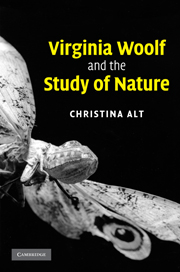Book contents
- Frontmatter
- Contents
- Acknowledgements
- List of abbreviations
- Introduction
- 1 The natural history tradition
- 2 The modern life sciences
- 3 ‘To pin through the body with a name’: Virginia Woolf and the taxonomic tradition
- 4 Laboratory coats and field-glasses: Virginia Woolf and the modern study of nature
- 5 Representing ‘the manner of our seeing’: Literary experimentation and scientific analogy
- Notes
- Bibliography
- Index
5 - Representing ‘the manner of our seeing’: Literary experimentation and scientific analogy
Published online by Cambridge University Press: 04 August 2010
- Frontmatter
- Contents
- Acknowledgements
- List of abbreviations
- Introduction
- 1 The natural history tradition
- 2 The modern life sciences
- 3 ‘To pin through the body with a name’: Virginia Woolf and the taxonomic tradition
- 4 Laboratory coats and field-glasses: Virginia Woolf and the modern study of nature
- 5 Representing ‘the manner of our seeing’: Literary experimentation and scientific analogy
- Notes
- Bibliography
- Index
Summary
Woolf's familiarity with trends in the life sciences led her to draw upon the study of nature as a source of analogy when considering methods of representing life in fiction. Collection and classification have been recognised before as metaphors important to Woolf's conception of writing. As I noted in the introductory chapter, critics such as Richter and Robinson have interpreted the hunting of moths and the netting of butterflies as analogies for Woolf's own creative process, while Sarsfield regards ‘the question of how to “pin down” life in words without destroying it, to “pin” the moth without killing’ as a ‘perennial dilemma’ for Woolf and sees no solution to the ‘writing = pinning = killing conundrum’ in Woolf's work. Whether they assume Woolf's approval or disapproval of collection and classification as a metaphor for writing, Richter, Robinson, and Sarsfield are alike in regarding the taxonomic method as the sole analogy for the writing process that Woolf drew from the life sciences. In fact, however, Woolf also drew analogies from other, emergent approaches to the study of nature. Reflecting contemporary scientific attitudes, Woolf employed the taxonomic method as a symbol of a limited mode of representation while taking disciplines focused on the observation of living organisms as analogies for new methods of seeing and describing life. In place of a literary method focused on exhaustive description in the service of definitive classification, Woolf advocated acceptance of the fact that only fleeting glimpses of a moving subject were possible or, indeed, desirable.
- Type
- Chapter
- Information
- Virginia Woolf and the Study of Nature , pp. 168 - 191Publisher: Cambridge University PressPrint publication year: 2010



